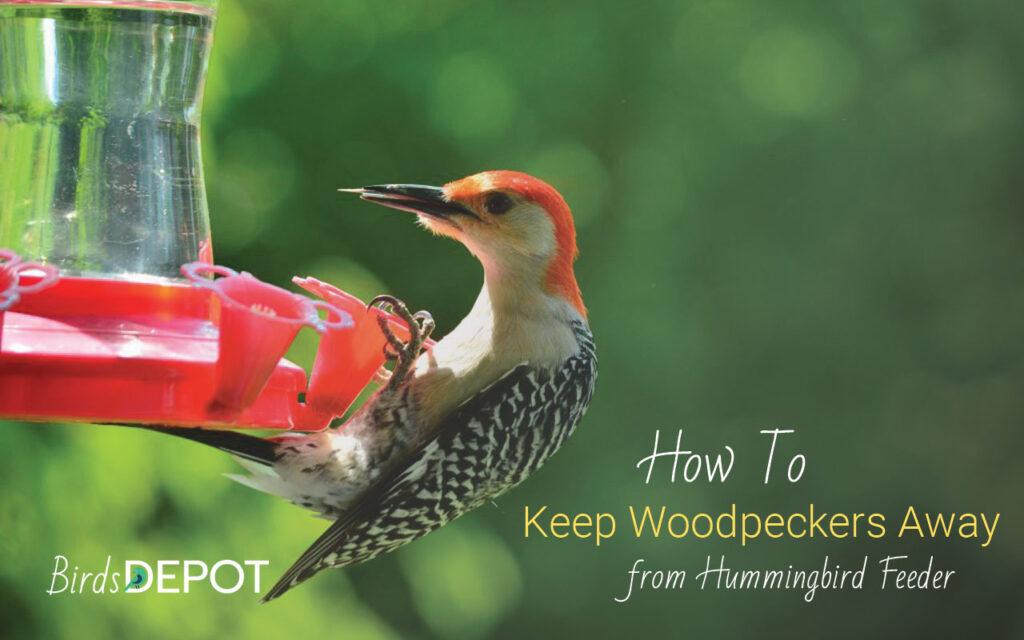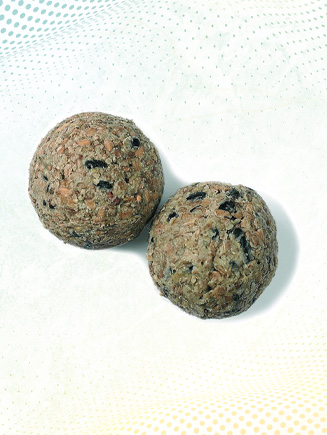As a bird lover and enthusiast, you’ve likely experienced the joy of watching hummingbirds flit around your garden. These tiny, iridescent creatures bring life and color to our outdoor spaces. But what happens when woodpeckers decide to crash the party? Not only do they scare away our beloved hummingbirds, but they can also wreak havoc on our carefully placed feeders.
In this comprehensive guide, we’ll explore practical strategies for keeping woodpeckers at bay and ensuring that hummingbirds continue to thrive.

Are hummingbirds afraid of woodpeckers?
Hummingbirds tend to feed on similar species. When they see a large bird in their feeding area, they avoid it because they perceive larger birds as predators. Therefore, when hummingbirds observe woodpeckers or other large birds consuming nectar from their feeder, they avoid using the feeder out of fear of the woodpeckers and other large birds.
Woodpeckers at your hummingbird feeder?
Hummingbird feeders, brimming with sweet nectar, are a shared resource. Both woodpeckers and hummingbirds are drawn to these sugary havens. However, their behavior differs significantly:
- Hummingbirds:
- Hover while feeding, allowing them to use perch-less feeders.
- Delicate and agile, they sip hummingbird nectar gracefully.
- Woodpeckers:
- Heavier and longer, they require a stable perch before accessing nectar.
- Their pecking behavior can damage feeders and scare away hummingbirds.
The predicament lies in finding solutions that deter woodpeckers without disturbing our tiny, fluttering friends.
Do woodpeckers drink hummingbird nectar?
It’s surprising to many people when they first see woodpeckers drinking nectar, but it’s true – they are drawn to it. However, not all types of woodpeckers enjoy drinking hummingbird nectar.
Typically, you’ll find specific types at hummingbird feeders that prefer to feed on sap and flower nectar. These woodpeckers include:
-
- Acorn
-
- Downy
-
- Gila
-
- Red-Bellied
Why Do Woodpeckers Eat Sugar Water?
Woodpeckers are not typically drawn to sugar water specifically as a primary food source. However, research found woodpeckers clearly prefer sugars and amino acids over water, and their taste receptors are highly sensitive to sugars. Hummingbirds and peckers share several similarities, including specialized tongues for nectar extraction, adaptations for hovering flight, and a shared love for sugary drinks.
How to keep woodpeckers away from hummingbird feeders?
Modify the Feeder Setup
To discourage tree-knockers, consider hanging your hummingbird feeders away from trees and structures where woodpeckers commonly perch. Position the feeders at least 10 feet away from potential perching spots to minimize the risk of sapsucker disturbances.
Provide Alternative Food Sources
To divert woodpeckers’ attention away from your hummingbird feeders, consider setting up suet feeders or other woodpecker-friendly food sources in a different area of your garden or balcony. Offering alternative food sources can satisfy woodpeckers’ foraging instincts, reducing their reliance on your hummingbird feeders. You can also introduce a large feeder that contains nectar or sugar water to keep them away from hummingbirds’ small feeders.
Woodpeckers like to take black oil sunflower seeds, mealworms, suet, peanuts, grains, etc. But, among all, they have an extra attraction on suet. So, you can also introduce a suet feeder in your yard. We recommend using suet cake containing sunflowers, peanuts, safflower and millet, which provide the best results.
Use fat balls with mealworms
Fat Balls with Insects and Meal Worm
Packed with protein rich dried mealworm and insects. A favourite for wild birds.
Woodpeckers love Insects and Mealworms. Place a suet feeder containing fat balls or suets mixed with them. They will spend hours digging through the fatballs and trying to reach the mealworms, leaving the sugar feeder alone.
Perchless hummingbird feeder
The common difference between their feeding styles is that hummingbirds like to sip while on a flight, while woodpeckers like to perch. So, I hope you understand what your task is now. You need to introduce a hummingbird feeder without a perch. Don’t worry; it does not decline your yard hummingbird traffic.
Gray Bunny Hummingbird Feeders for Outdoors Hanging
You can hang this Perchless hummingbird feeder on trees, stands, or hooks.
For this, the easiest way to keep them away from your yard is to introduce anti-woodpecker hummingbird feeders, which means a perchless feeder.
Use baffle
Sometimes, you will notice these tree knockers trying to get nectar by perching on the top of the feeder or grabbing the hanging wire that does not come with perches. They get paid for their hard work by getting nectar. So, you need to stop them from perching on the top of the feeder.
So, you need to attach a baffle to the top of the feeders. We We recommended using this Bird Feeder Baffle form Soundfair. Alternatively, you can also use a flat surface plate or an old CD. But before using the old CD as a baffle, you need to remove the shiny parts that reflect sunlight. Otherwise, it will keep woodpeckers and hummingbirds away.
House Placement
Install woodpecker houses away from hummingbird feeders to provide an alternative nesting spot for woodpeckers. This helps prevent competition between the woodpeckers and hummingbirds, allowing both species to thrive in their own spaces. Woodpeckers may also be less likely to damage the hummingbird feeder if they have their designated area to feed and nest. This simple adjustment can create a more harmonious backyard environment for both bird species.
Netting and Acorn Removal
Woodpecker Nets: Install bird netting around feeders. It’s an effective way to deter larger birds and woodpeckers from damaging hummingbird feeders. Installing bird netting around any feeders or birdhouses will prevent them from accessing the nectar, which is still easily accessible by tiny hummingbirds. This can be especially helpful if you are experiencing repeated woodpecker attacks on your bird feeders.
Acorn Cleanup: Rake up acorns to reduce woodpecker attraction. Woodpeckers can be attracted to areas with an abundance of acorns, as they can find insects and larvae in the fallen nuts. By cleaning up acorns regularly, you can reduce the food source that attracts woodpeckers to your yard.
Plant woodpeckers friendly plant
Peckers are naturally drawn to natural food sources. To deter them from the hummingbirds’ feeder, consider introducing natural food such as berry bushes or a small orchard of fruit trees, which woodpeckers favor. Maintaining a reasonable distance between these plants and the feeder is important to prevent the woodpeckers from being attracted to it.
Use Visual Deterrents
Visual deterrents can startle woodpeckers and deter them from approaching your feeders. Hang reflective objects such as CDs or aluminum foil strips near the feeder to create flashes of light that can scare away these fellas. These simple yet effective measures can significantly reduce woodpecker activity around your feeders.
Employ Auditory Deterrents
Playing recordings of woodpecker distress calls can effectively discourage them from visiting your feeders. Download woodpecker distress calls online and play them using speakers positioned near the feeder. The sound of distressed woodpeckers will signal danger to others in the area, deterring them from approaching your feeders.
Woodpecker Species to Watch Out For
-
- Downy Woodpecker: Downy Woodpeckers are known for their drumming behavior, which involves rapid pecking on various surfaces. When they encounter a hummingbird feeder, Downy Woodpeckers may peck at the feeder, causing damage to the feeder’s structure. This can lead to leaks or spills of sugar water, potentially deterring hummingbirds from feeding.
-
- Hairy Woodpecker: Hairy Woodpeckers exhibit behavior similar to Downy, including drumming and pecking. Their larger size can cause more significant damage to hummingbird feeders with their powerful pecking, which can result in structural damage that compromises the feeder’s functionality.
-
- Northern Flickers: Northern Flickers are primarily ground feeders, foraging for insects, seeds, and berries on the ground or in trees. However, they may also investigate hummingbird feeders hanging from trees or poles. If they attempt to access hummingbird feeders, they can cause substantial damage. Their strong, chisel-like bills can easily puncture feeder tubes or ports.
If you are facing damaged feeder issues, read our guide on fixing Hummingbird feeders.
In addition to these methods, you may consider planting bird-friendly plants and trees to provide natural food sources for woodpeckers and other birds. Creating a diverse and welcoming habitat for wildlife can help reduce the likelihood of woodpeckers causing damage to your property.
Following these practical tips, you can establish a harmonious backyard ecosystem where both species can thrive. Keep an eye on your feeders, ensure they stay clean, and offer woodpeckers attractive alternatives. Let’s work together to maintain our gardens as a haven for all our feathered friends!

